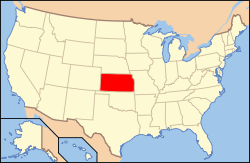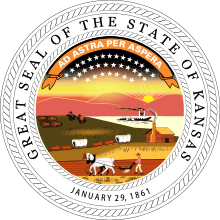Norton County, Kansas
| Norton County, Kansas | |
|---|---|
| County | |
|
Norton County Courthouse in Norton | |
 Location in the U.S. state of Kansas | |
 Kansas's location in the U.S. | |
| Founded | February 26, 1867 |
| Named for | Orloff Norton |
| Seat | Norton |
| Largest city | Norton |
| Area | |
| • Total | 881 sq mi (2,282 km2) |
| • Land | 878 sq mi (2,274 km2) |
| • Water | 3.2 sq mi (8 km2), 0.4% |
| Population | |
| • (2010) | 5,671 |
| • Density | 6.5/sq mi (3/km²) |
| Congressional district | 1st |
| Time zone | Central: UTC-6/-5 |
| Website |
NortonCounty |
Coordinates: 39°48′N 99°55′W / 39.800°N 99.917°W
Norton County (standard abbreviation: NT) is a county located in the U.S. state of Kansas. As of the 2010 census, the county population was 5,671.[1] The largest city and county seat is Norton.[2] The county was established in 1867 and named for Orloff Norton, captain of Company L, 15th Kansas Militia Infantry Regiment.[3]
History
Early history
For many millennia, the Great Plains of North America was inhabited by nomadic Native Americans. From the 16th century to 18th century, the Kingdom of France claimed ownership of large parts of North America. In 1762, after the French and Indian War, France secretly ceded New France to Spain, per the Treaty of Fontainebleau.
19th century
In 1802, Spain returned most of the land to France, but keeping title to about 7,500 square miles. In 1803, most of the land for modern day Kansas was acquired by the United States from France as part of the 828,000 square mile Louisiana Purchase for 2.83 cents per acre.
In 1854, the Kansas Territory was organized, then in 1861 Kansas became the 34th U.S. state. Norton County was founded by Noah H. Billings, Thomas Beaumont, Henry Gordon, P. Hansen, and George Cole on August 22, 1872. In 1878 Norton became the county seat. The county gets its name for Civil War soldier Orloff Norton, who was killed at Cane Hill, Arkansas in 1864.
The first county fair, although not official, was held in Leota in October, 1878. After 1900 the fair was held yearly in Elmwood Park in Norton. The first school district was formed in Norton in 1872. School was held in a dugout beginning December 1, 1873.
20th century
On February 20, 1933, people in Norton and Decatur counties felt a moderate earthquake. Buildings and houses swayed and dishes and windows rattled. The earthquake was felt across a 6,000 square mile area in Kansas and Nebraska.
Geography
According to the U.S. Census Bureau, the county has a total area of 881 square miles (2,280 km2), of which 878 square miles (2,270 km2) is land and 3.2 square miles (8.3 km2) (0.4%) is water.[4]
Adjacent counties
- Furnas County, Nebraska (north)
- Harlan County, Nebraska (northeast)
- Phillips County (east)
- Graham County (south)
- Sheridan County (southwest)
- Decatur County (west)
Demographics

| Historical population | |||
|---|---|---|---|
| Census | Pop. | %± | |
| 1880 | 6,998 | — | |
| 1890 | 10,617 | 51.7% | |
| 1900 | 11,325 | 6.7% | |
| 1910 | 11,614 | 2.6% | |
| 1920 | 11,423 | −1.6% | |
| 1930 | 11,701 | 2.4% | |
| 1940 | 9,831 | −16.0% | |
| 1950 | 8,808 | −10.4% | |
| 1960 | 8,035 | −8.8% | |
| 1970 | 7,279 | −9.4% | |
| 1980 | 6,689 | −8.1% | |
| 1990 | 5,947 | −11.1% | |
| 2000 | 5,953 | 0.1% | |
| 2010 | 5,671 | −4.7% | |
| Est. 2015 | 5,550 | [5] | −2.1% |
| U.S. Decennial Census[6] 1790-1960[7] 1900-1990[8] 1990-2000[9] 2010-2013[1] | |||
As of the 2000 US census, there were 5,953 people, 2,266 households, and 1,470 families residing in the county. The population density was 7 people per square mile (3/km²). There were 2,673 housing units at an average density of 3 per square mile (1/km²). The racial makeup of the county was 93.35% White, 4.05% Black or African American, 0.44% Native American, 0.42% Asian, 0.02% Pacific Islander, 1.02% from other races, and 0.71% from two or more races. 2.37% of the population were Hispanic or Latino of any race.
There were 2,266 households out of which 28.20% had children under the age of 18 living with them, 55.50% were married couples living together, 7.00% had a female householder with no husband present, and 35.10% were non-families. 32.30% of all households were made up of individuals and 17.90% had someone living alone who was 65 years of age or older. The average household size was 2.28 and the average family size was 2.89.
In the county the population was spread out with 22.00% under the age of 18, 7.70% from 18 to 24, 28.30% from 25 to 44, 22.30% from 45 to 64, and 19.60% who were 65 years of age or older. The median age was 40 years. For every 100 females there were 122.10 males. For every 100 females age 18 and over, there were 122.90 males.
The median income for a household in the county was $31,050, and the median income for a family was $37,036. Males had a median income of $25,983 versus $20,381 for females. The per capita income for the county was $16,835. About 6.10% of families and 10.50% of the population were below the poverty line, including 12.70% of those under age 18 and 8.20% of those age 65 or over.
Law and government
Following amendment to the Kansas Constitution in 1986, the county remained a prohibition, or "dry", county until 1992, when voters approved the sale of alcoholic liquor by the individual drink with a 30% food sales requirement.[10]
Noah H. Billings was an early county settler, county superintendent of schools, county attorney, and state representative. Keith Sebelius served as a U.S. congressman from 1969 to 1981.[11]
Education
Unified school districts
- Norton Community USD 211
- Northern Valley USD 212
- West Solomon USD 213 (elementary school only; students in grades 6-12 attend schools in Norton)
Communities

Cities
Townships
Norton County is divided into four townships. The city of Norton is considered governmentally independent and is excluded from the census figures for the townships. In the following table, the population center is the largest city (or cities) included in that township's population total, if it is of a significant size. The 2010 census shows the area of the former Harrison-District 6 as combined into that of Almena-District 4.
| Township | FIPS | Population center |
Population | Population density /km² (/sq mi) |
Land area km² (sq mi) | Water area km² (sq mi) | Water % | Geographic coordinates |
|---|---|---|---|---|---|---|---|---|
| Almena-District 4 | 01450 | 614 | 2 (6) | 278 (107) | 0 (0) | 0% | 39°53′10″N 99°41′2″W / 39.88611°N 99.68389°W | |
| Center-District 1 | 12260 | 1,382 | 2 (5) | 654 (253) | 0 (0) | 0.08% | 39°53′43″N 99°57′2″W / 39.89528°N 99.95056°W | |
| Harrison-District 6 (defunct[12]) | 30460 | 12 | 0 (0) | 93 (36) | 0 (0) | 0.02% | 39°56′54″N 99°48′25″W / 39.94833°N 99.80694°W | |
| Highland-District 2 | 32060 | 737 | 1 (3) | 748 (289) | 9 (3) | 1.13% | 39°41′24″N 100°1′49″W / 39.69000°N 100.03028°W | |
| Solomon-District 3 | 66410 | 196 | 0 (1) | 496 (192) | 0 (0) | 0.02% | 39°40′38″N 99°45′56″W / 39.67722°N 99.76556°W |
See also
|
|
References
- 1 2 "State & County QuickFacts". United States Census Bureau. Retrieved July 27, 2014.
- ↑ "Find a County". National Association of Counties. Retrieved 2011-06-07.
- ↑ Blackmar, Frank Wilson (1912). Kansas: A Cyclopedia of State History, Volume 2. Standard Publishing Company. p. 374.
- ↑ "US Gazetteer files: 2010, 2000, and 1990". United States Census Bureau. 2011-02-12. Retrieved 2011-04-23.
- ↑ "County Totals Dataset: Population, Population Change and Estimated Components of Population Change: April 1, 2010 to July 1, 2015". Retrieved July 2, 2016.
- ↑ "U.S. Decennial Census". United States Census Bureau. Retrieved July 27, 2014.
- ↑ "Historical Census Browser". University of Virginia Library. Retrieved July 27, 2014.
- ↑ "Population of Counties by Decennial Census: 1900 to 1990". United States Census Bureau. Retrieved July 27, 2014.
- ↑ "Census 2000 PHC-T-4. Ranking Tables for Counties: 1990 and 2000" (PDF). United States Census Bureau. Retrieved July 27, 2014.
- ↑ "Map of Wet and Dry Counties". Alcoholic Beverage Control, Kansas Department of Revenue. November 2006. Retrieved 2007-12-26.
- ↑ Norton County, Kansas, Kansas Historical Society
- ↑ Kansas State Historical Society
Further reading
- History of the State of Kansas; William G. Cutler; A.T. Andreas Publisher; 1883. (Online HTML eBook)
- Kansas : A Cyclopedia of State History, Embracing Events, Institutions, Industries, Counties, Cities, Towns, Prominent Persons, Etc; 3 Volumes; Frank W. Blackmar; Standard Publishing Co; 944 / 955 / 824 pages; 1912. (Volume1 - Download 54MB PDF eBook),(Volume2 - Download 53MB PDF eBook), (Volume3 - Download 33MB PDF eBook)
External links
| Wikimedia Commons has media related to Norton County, Kansas. |
- County
- Maps
- Norton County Maps: Current, Historic, KDOT
- Kansas Highway Maps: Current, Historic, KDOT
- Kansas Railroad Maps: Current, 1996, 1915, KDOT and Kansas Historical Society
 |
Red Willow County, Nebraska | Furnas County, Nebraska | Harlan County, Nebraska |  |
| Decatur County | |
Phillips County | ||
| ||||
| | ||||
| Sheridan County | Graham County | Rooks County |
